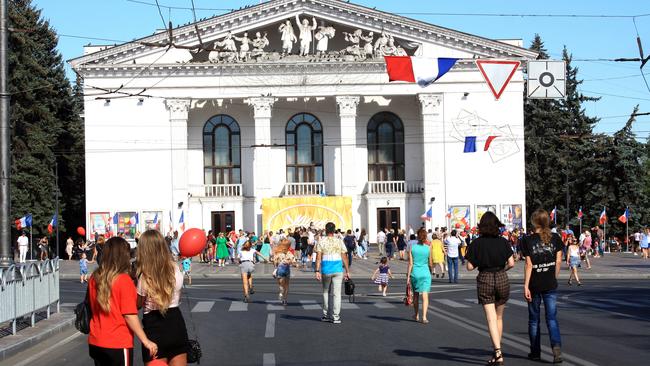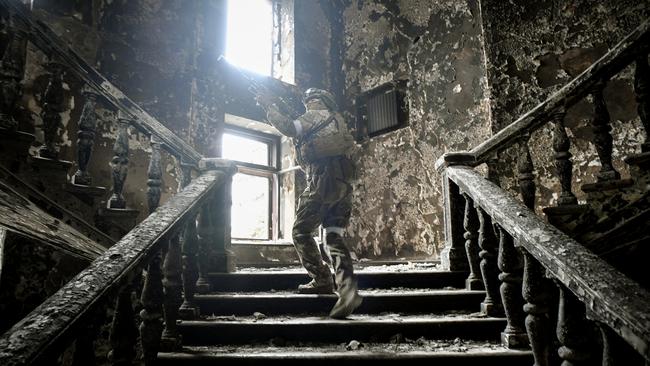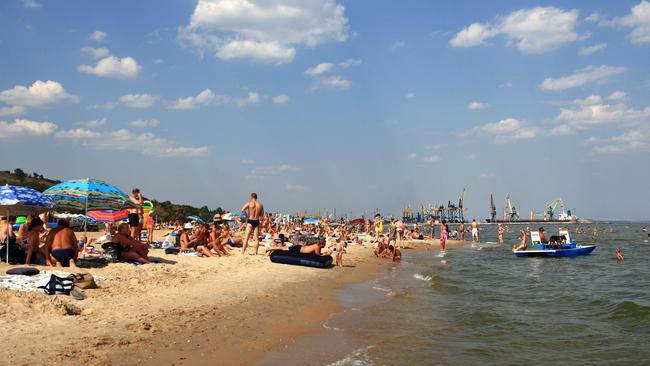Before the curtain fell: memories of Mariupol
Today it’s synonymous with siege and suffering. But not long ago the Ukrainian port of Mariupol was thronging with carefree crowds.

Mariupol’s residents were in high spirits, commemorating the arrival of the Russians. It was September 2017 and children wearing 1940s fancy dress gathered by classic cars to mark the 74th anniversary of the Red Army’s liberation of the city from the Nazis in 1943. Around them, plumes of water shot from a fountain as proud parents took photos and elderly couples strolled through the central, tree-lined plaza in the sun. The city’s handsome theatre lay at one end of the square, with its neoclassical façade and bill of classic and contemporary plays.
A short drive down the coast, the World War II commemorations continued. Young soldiers and veterans gathered on a beach where Soviet troops had once landed to push back the German army. A memorial was unveiled and servicemen boarded a naval vessel to place a wreath at sea.
A photographer friend and I watched these scenes unfold on that bright autumn day, years before Mariupol became a byword for siege and suffering. Of course, by then, this port city had already experienced some of Russia’s firepower. It had briefly fallen under the control of Russian-backed separatists in May 2014 and came under multiple attacks as war raged across the Donbas region. The following year, however, nearby frontline positions stopped shifting and, although intermittent shelling persisted outside Mariupol, it was still possible, in the calm city centre, to forget that hostilities were rumbling on. That has all changed, completely and catastrophically. Since Vladimir Putin launched an invasion of Ukraine in February, the world has watched in horror as Russian forces have laid siege to Mariupol. The joyful, carefree scenes I witnessed in the city several years ago have been replaced by an unimaginable nightmare.
Russian rockets have reduced once-bustling neighbourhoods to desolate wastelands, dotted with the charred husks of ruined apartment blocks. Bodies of civilians have piled up in mass graves; the city’s mayor has put the death toll at more than 10,000. Those still alive, cold and starving, have been forced to melt snow to drink, burn furniture for warmth and run the gauntlet of shellfire to find scraps to eat. Moscow has repeatedly dangled the promise of “humanitarian corridors” for the tens of thousands trapped inside the city, only for its army to shell escape routes and delay evacuations – a cynical, morale-sapping tactic well-practised by Russian forces during Syrian sieges.
Perhaps more than anything, Mariupol’s theatre has become the emblem of this barbaric assault. Years earlier, I had seen children gathered outside this building, which stood for high culture and free expression, and now exists as a rubble-strewn coffin after a Russian strike targeted it while hundreds sheltered in the basement. In April, Putin said that Mariupol had fallen to Russian forces, before his troops moved on the last bastion of Ukrainian resistance at the Azovstal steel plant.
Such horrors place Mariupol alongside Aleppo, Grozny and other infamous urban battlegrounds that have borne the pitiless brunt of Russian military attacks. But the city wasn’t always like this. I remember another Mariupol.

As we sped out of Donetsk and cleared the buffer zone between the Ukrainian army and Russian-backed separatists, our driver, Igor, crossed himself and pressed southward towards the coast. It was July 2015 and this visit to Mariupol was my first trip out of the so-called Donetsk People’s Republic, a Russian- controlled breakaway enclave, since I had arrived in the east a month earlier to report on the war. After driving through a checkpoint made from huge concrete tank traps, and past fields of sunflowers, my colleague and I arrived in Mariupol later that morning. A clear change in atmosphere brought with it a great sense of relief, like a weight lifting from my chest. Reporting in Donetsk had involved working within the confines of a repressive regime that enforced its rule with abductions, torture and executions. Here in government-held territory, the sense of increased safety and sovereignty was refreshing.
Mariupol, located at the mouth of the Kalmius River, had a pleasant, relaxed feel. Life moved at an unhurried pace along its wide boulevards and, in the summer heat, came with a faint Mediterranean flavour, thanks in part to the Azov Sea and the city’s sizeable population of ethnic Greeks. Amid the usual fare of drab, Soviet-era architecture, Mariupol boasted some lovely old buildings from the 19th and early 20th centuries – some carefully maintained, others delightfully ramshackle.
The beach was the main draw, though reminders of the war persisted. Families played on the sand while men sipped beer from plastic cups and women sunbathed next to razor-wire fences where signs warned of nearby landmines. The port further up the beach offered a dramatic industrial backdrop, where cranes towered over the murky water like a pack of colossal, prehistoric beasts.
Part resort, part steelworks, part frontline city, Mariupol was a place of confounding contrasts. The Red Army commemorations of 2017 unfolded even as Ukrainian soldiers were fighting Russian- backed forces on the nearby frontline. As with much of Donbas, the city was closer to Russia – linguistically, culturally, economically – than other Europe-facing parts of the country, although fending off Russian aggression since 2014 had helped shape and solidify its Ukrainian identity.
The past eight years have allowed the city – “a dying Soviet industrial monster”, in the words of my fixer, Dima Halko – to reinvent itself. “By 2021, I’d grown to love it because it had changed a lot,” he told me. “It was getting more and more modern.” Dima thinks it is Mariupol’s decision to slough off its Soviet past and embrace a more Ukrainian future that has fuelled Russia’s punishing bombardment of the city today. “It seems to me Russians hate Mariupol, just because of this. They failed to conquer it and it thrived without them. One could easily see the difference between Mariupol and those cities under Russian control. It pissed them off a lot, I guess. And now they are taking revenge on Mariupol and its people.”
After my first trip to the city in 2015, I returned numerous times. I headed back that October to report on local elections, the pullback of frontline Ukrainian tanks and the threat of unexploded ordnance in the surrounding countryside. One rainy afternoon I settled into a cosy, underground bar, writing up a piece about the separatists’ blacklisting of Médecins Sans Frontières doctors from their breakaway territory, and ordered a delicious cheeseburger and craft ale worthy of any hipster joint in western Europe.
The following drizzly day, I headed to an outer suburb of high-rise flats to interview 65-year-old Gregory Voyevoda, who had been injured by an anti-tank mine. His terrible wounds included third-degree burns, shattered bones, shredded forearm muscles and legs pumped with shrapnel. Ye he shrugged off the horror with typical Ukrainian fatalism, saying he held no grudge against the soldier who laid the mine. “War is war,” he said. “All our factories can be destroyed and rebuilt. All our men can be killed and women will give birth again. Our land, though, can never be replaced. You must use anything to protect it.”

That evening I was introduced to the city’s small but thriving music scene by Viktoria Popova, who had been working as my translator. In a low-lit bar, musicians took turns on stage while the audience drank beer and kicked back in defiance of the smouldering conflict on their doorstep. “It’s a lovely city with strong, wonderful people,” Viktoria told me by phone recently. She became a good friend and later moved with her husband to Germany; we got back in touch in April as the Russians surrounded the city, trapping her parents inside. “My happiest memories were in Mariupol. Now seeing it being completely broken down… it’s a nightmare.”
Mariupol’s beguiling contrasts would persist with every visit. In September 2016, I met up with a group of aid workers and headed out to a community of pensioners living in a frontline village not far away. “I’m frightened all the time,” 80-year-old Nadiya Davidenko told me. “I barely sleep any more, whether there’s fighting or not.” Later that day, back in Mariupol, a friend and I went out for dinner and then headed to a bar by the sea. It was hard not to feel guilty about our good fortune, given the misery we had seen just a few hours earlier.
The following year, another assignment took me to a seaside community on Mariupol’s outskirts where I spent an afternoon with a group of fishermen. Tangled nets littered an otherwise empty beach as wooden dinghies bobbed on the flat sea. It looked like a serene picture of a faded seaside village, but not for these men. Displaced by war and banned from returning to their ruined village nearby, these exiles were eking out a living in this sun-bleached community.
Still, the men retained a love for the coastal areas around Mariupol, and told me so in words that now resonate with a grim sense of fate. “Here, my soul is free,” said Nikolai Gnatoshenko. “I can stroll on the beach, take my boat out to sea. Bad things can happen anywhere – God decides when we die so I’m not afraid.”
Back in the city, Viktoria and I headed down to the quay where we met two fishermen, Vanya and Dima, as they waited for a delivery of ice. Across the water lay Azovstal, a major employer, now transformed into an industrial hellscape by the relentless Russian bombing. “This crisis has been made by people who want more and more, who are never satisfied,” Vanya told me. “We’ve always been at the centre of competing empires. But I’m proud of this. It’s made us stronger.”
After that trip in 2017, I was ready for a change and decided to return only if something major happened in Ukraine. Warnings of an impending invasion drew me back in mid-February this year, and I ended up reporting from Kyiv, Avdiivka in Donbas, and from Kharkiv. I considered visiting Mariupol again – a city that had offered me a strange kind of sanctuary all those years ago. But I never made it back there. As it lies in ruins, annihilated by the Russian army, I wonder if I ever will.

To join the conversation, please log in. Don't have an account? Register
Join the conversation, you are commenting as Logout